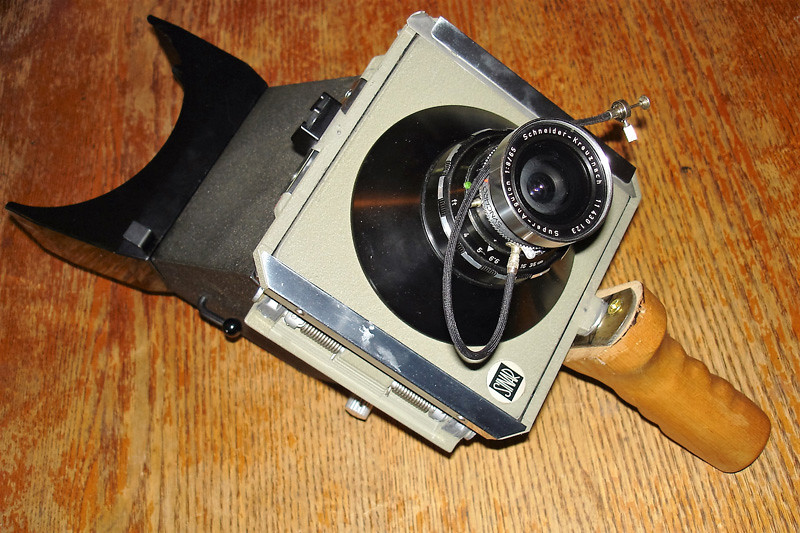Thanks! May take me a while to organise some film and a back, but a processing tank is a good start. 70mm backs are still some of the more affordable Hasselblad types, so it's probably a good excuse to begin keeping an eye out for one, I already have the camera body and a few lenses. I lost track of this discussion for a while after the first couple of pages so I'll have to go back and educate myself more about the 70mm format. The thread's certainly got legs, I'm surprised, (but pleased), to see so much interest in 70mm.
Cheers,
Brett
Brett,
Getting a 15 foot reel and a daylight tank is not so easy. Consider yourself lucky.
I have three 15 foot reels: two are the stainless steel reels that Dan dipicted that have spokes like wagon wheels; and one is like yours.
The single reel tank I have is a Nikor non daylight tank that resembles a small stainless steel hat or cake box. I think I can cut down a JOBO Expert 3063 tank so I can create a three reel daylight inversion tank.
I shot some Rollie 400S in 120 over the weekend and processed it using Diafine. The reason I am shooting Rollie 400S in 120 is for short roll testing, as Rollie 400S is available for less than a dollar a foot in 70mm and it is fresh film.
In another thread I found out that the 400S film speed is greatly exaggerated by MACO and it really is a 80-100 ISO film. I researched this film a bit and it kinda is high contrast, where it kinda has a natural "S" curve kinda built in, so moderating contrast is required if one is going to try and use this film for full tonal range.
With Diafine, a compensating developer that moderates contrast, I had some good encouraging results. The good is that this film in Diafine is fine grained. I was able to get full tonality with a nice midrange by doing a list of tricks to effectively "pull" the film with a pushing developer.
Here's what I did. I shot off of an eight story building's rooftop around 9:30 AM under a blue cloudless sky. The lighting was mucho high key of low rise in the foreground and UES highrise in the distance. I was shooting a Plaubel 69W with a 47/5.6 with a 21mm FOV stopped down to F11.
I developed in a 500ml stainless steel daylight tank, but I used a Hewes 220 reel to resemble the tighter spacing that resembles one of my 15 foot reels. This reel fits snuggly and has absolutely no "piston" factor when inverting. Know that this is important because with Diafine I tend to underdevelop by only doing two gentle inversions per minute instead of the recommended three inversions per minute. With other films like Tri-X and FP4 I extend the development from 3+3 to 4+4, so this is what I did with this first test roll.
So here is the bad. My best negatives suggest perhaps 50-80 ISO, so effectively I'm pulling the film to get nice midrange, but sacrificing film speed. I think my next test will be in a 1 liter tank because I see traces of Bromide Drag in the sky on some negatives. Just a trace, most noticable when the negatives are wet, but I believe with just a tad of "piston" play during an inversion is enough to increase the circulation enough to avoid the Bromide Drag I see from the 500ml tank. With Rollie 400S it seems I made the negatives a bit too thin by going 4+4, and next time I will do 3+3. Know I am trying to optimize my negatives for wet printing so I want more density that for scanning.
Understand that Diafine is a two part developer. Part "A" only soaks into the emulsion, no real development takes place during this soaking, and it is really only when Part "B" is in the tank that the real development takes place.
I found that by minimizing aggitation that it makes for smaller grain, wher Tri-X is almost as fine grained as Acros.
I found that the recommended ISO's for Diafine are way aggressive. The highlights kinda get a stand development treatment, the shadow detail is inately enhanced, but the mids are controlled by ISO. I think if I cut the development to 3+3 I might get an honest 80 ISO.
I will be trying Microphen also, but instead of using the recommended 8 minutes stock and 4 inversions per minute I will try to get a compensating effect by halving the inversions to only 2 a minute and extending development to perhaps 11 minutes. Basically halve the inversions and extend development 30%. Basically I'm trying to flatten an "S" curve that is built into Rollie 400S. My thinking is if I can get 160 ISO with Microphen then I can use Rollie 400S as my medium speed film.
For a slow speed film I expect Rollie 400S in Diafine "pulled" for 50-80 ISO. These negatives are like no grain and highly detailed. Particularly great for landscape because there is an extended IR range that cuts through the filth, pollution and haze of NYC.
So far Rollie 400S is looking mighty good. I figure about $2.50 per 120 equiv plus bonus exposures when shooting 15 foot lengths.
Cal
 4x5 Handy type camera from China by Nokton48, on Flickr
4x5 Handy type camera from China by Nokton48, on Flickr Handy type camera from China 3 by Nokton48, on Flickr
Handy type camera from China 3 by Nokton48, on Flickr 4x5 Handy type camera from China by Nokton48, on Flickr
4x5 Handy type camera from China by Nokton48, on Flickr Handy type camera from China 3 by Nokton48, on Flickr
Handy type camera from China 3 by Nokton48, on Flickr




